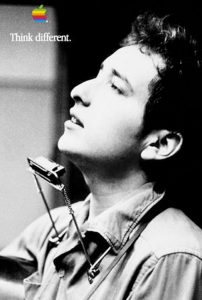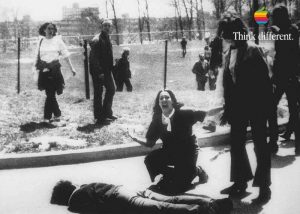Welcome to UBC Blogs. This is your first post. Edit or delete it, then start blogging!
Author Archives: jason roberts
Culture Jam Assignment: “Think Different”





I have selected a handful of print ads from Apple’s 1997 “Think Different” ad campaign. This was an extremely successful and very influential campaign that I found worthy of jamming not merely because of its specific problematics but because, to a large degree, this campaign was a leader in shifting the way that products are marketed and sold in an emerging neo-liberal, post-modern capitalism.
The campaign took influence from the then rapidly growing Nike. Nike, as Steve Jobs would say, never talked about their shoes or their products in their ads, but rather, cultivated an image—“they don’t ever talk about their products,” he said, “they don’t ever tell you about their air soles.” It was this principle that underlined the “Think Different” campaign. Completely bereft of images or even slight mention of Apple’s technological commodity products, the ads instead sought to powerfully associate Apple with a set of ideas. It was a step beyond the Freud and Reich influenced models of associating products with subconscious and irrational emotions either to fit in or express individuality. Instead, the company itself was positioned within a curated miasma of philosophical and emotional locus points. The consumer was guided towards belief and attachment to a brand rather than any specific product. By, positioning their logo alongside the slogan “Think Different” on top of photographs of famous historical figures that embodied a so-called ‘different’ kind of thinking, Apple positioned themselves, and by extension their products, into a sort of lineage with these figures. Consumption of Apple’s products became a matter of buying into this association and idea. In a post-modern culture that was becoming increasingly aware and reluctant of consumer culture and mass consumption, the ad campaign packaged an antidote to such worries within the product itself.
Thus, the “Think Different” ad campaign is one that, quite intentionally, sought to obfuscate the act of consumption from its footprint, to erase its own reason for existing from itself. It embodies a light-touch ‘sell’ that, when examined, reveals itself to be knee-deep in contradiction, which was precisely the point. The campaign was modeled on the basis of self-contradiction. To put it tritely, Apple is selling to consumers the idea that they, like the historical figures in the photographs, cannot be bought.





The Jamming philosophy I utilized was fairly straightforward. As mentioned in my prior analysis the “Think Different” ad campaign is steeped in contradiction. Apple, a multi-billion dollar company (even at the time of the campaign in 1997), positions itself in lineage with a string of historical figures that, for the most part, stood precisely opposite and against the very structures of power and capital that Apple embodies. What I did to reveal this contradiction was to swap out the photographs of these figures selected by Apple for the campaign with photos that more accurately show what these figures had to endure for their “different” thinking.
By using only portraits the Apple campaign offers a completely sanitized and an always already ordained view of these historical figures. They are removed from all material contexts or explicit politics and positioned within a nebulous, aestheticized space where their numerous and explicit revolutionary and transgressive voices are compressed into single, muted notation. Their ‘different thinking’ is, in this hindsight, appropriated and positioned into the historical canon of western capitalism—a canonization process that was already occurring to be sure, but is here expressed so explicitly for perhaps the first time.
By switching out these portraits with images that depict many of the real and material consequences that had to be paid for these figures’ transgressions, I hoped to undermine the appropriation of these figures for utilization in the selling of commodity products. The graphic political imagery is meant to block the aestheticizing and undermine the relay between Apple and consumer on what exactly this “different thinking” actually is. I deliberately chose violent images, utilizing Roland Barthes’ semiotic theories on signifier and signified–that graphic images of violence only depict themselves, resisting supplanted signifieds.